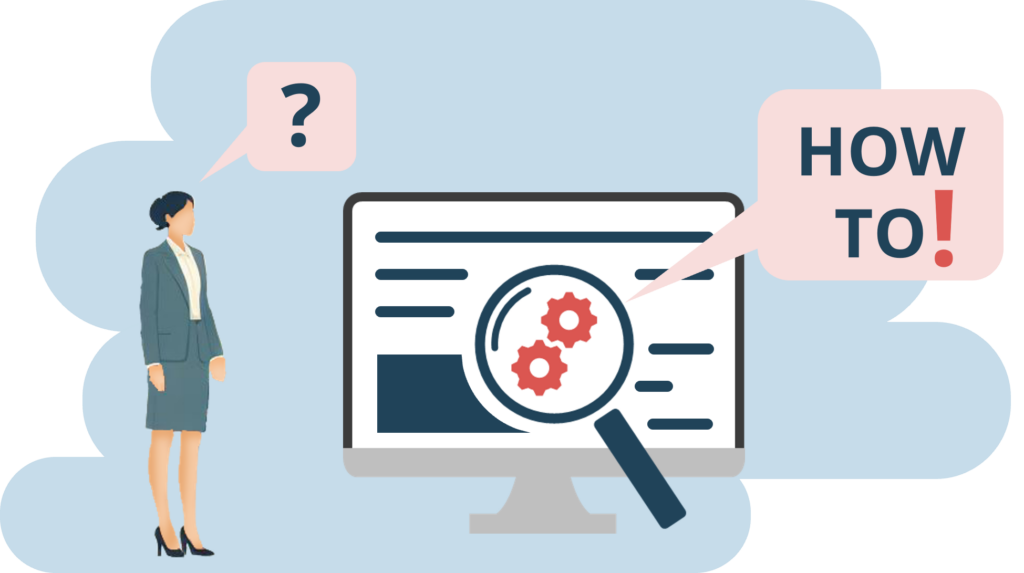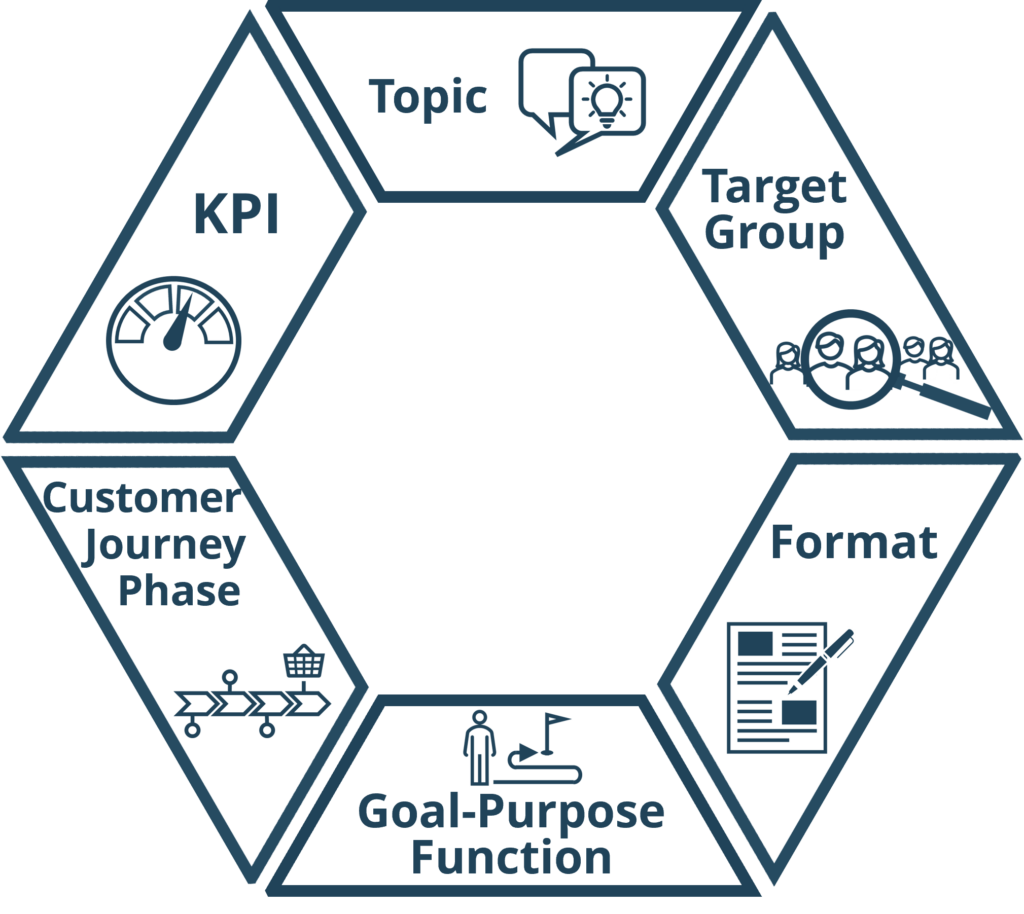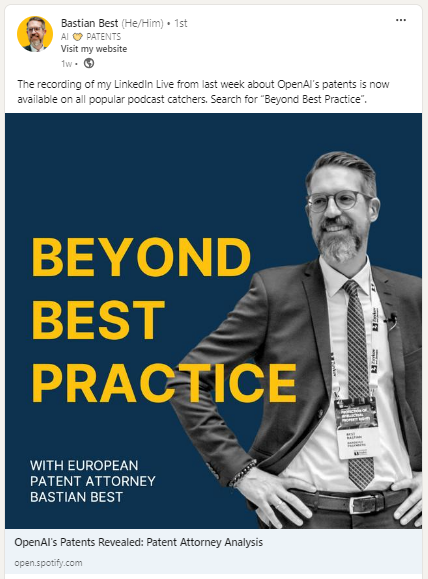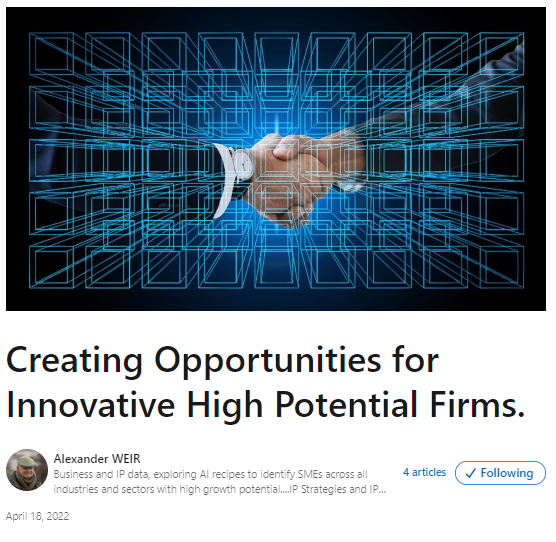|
|
Online Marketing Guide
|
Your inbox-insider from Prof. Wurzer every month
|
|
|
|
|
The topic of this special issue is Content Marketing for IP Experts:
|
- What is content marketing for IP experts?
- What are the success factors of content marketing for IP experts? Success Factors, components, types of content marketing
- Step by Step: How does content marketing work for me?
- Best practice from working with our partners
- If you have questions?
|
I wish you an exciting and informative read. I look forward to your comments and our exchange on LinkedIn.
|
|

|
|
|
|
|
What is Content Marketing for IP Experts?
|
|
|
|
|
Content marketing is a strategic approach to creating and distributing valuable, relevant, and consistent content to attract and retain a clearly defined audience, ultimately driving profitable customer action. In the context of expert branding, content marketing plays a crucial role in establishing thought leadership, building credibility, and positioning an individual or organization as an authority within their industry or field of expertise. I explain personal branding for IP experts in another online marketing guide.
|
Content marketing is an essential component of expert branding (personal branding for IP experts), enabling individuals or IP boutiques to establish thought leadership, build credibility and trust, position themselves as topic authorities, and drive engagement and lead generation. By consistently producing high-quality, valuable content and leveraging various distribution channels, IP experts can effectively communicate their expertise, differentiate themselves from competitors, and cultivate long-lasting relationships with their target audience.
|
Establishing Thought Leadership
|
One of the primary goals of content marketing for IP expert branding is to establish thought leadership. By consistently producing high-quality, informative, and insightful content, IP experts can demonstrate their knowledge, expertise, and unique perspectives on relevant topics. This content can take various forms, such as blog posts, whitepapers, case studies, webinars, podcasts, or videos. Through thought leadership content, IP experts can share their experiences, insights, and opinions, providing valuable information and solutions to their target audience's challenges and pain points. This not only helps to position the IP expert as a trusted and knowledgeable source but also to fosters a deeper connection with their audience and clients ultimately strengthening their personal brand.
|
Building Credibility and Trust
|
Credibility and trust are essential components of expert branding, and content marketing plays a vital role in cultivating both. By consistently delivering valuable and accurate information, IP experts can establish themselves as reliable sources within their audience. This credibility is further reinforced when content is well-researched, backed by data and evidence, and provides actionable insights or solutions. Additionally, content marketing allows experts to showcase their expertise through various formats, such as case studies or success stories, which can highlight their achievements, methodologies, and the positive impact they have had on their clients. This transparency and willingness to share knowledge and experiences can significantly enhance an IP expert's credibility and trustworthiness in the eyes of their audience.
|
Positioning as a Topical Authority
|
Effective content marketing can position IP experts as authorities within their respective industries or fields. By consistently producing high-quality, relevant content that addresses the most pressing issues, challenges, and trends within their audience, experts can establish themselves as go-to sources for valuable information and insights. Furthermore, content marketing can facilitate collaboration and engagement with other thought leaders, influencers, and publications. Guest blogging, contributing to IP community publications, or participating in podcasts or webinars can further solidify an IP expert's position as an authority and increase their visibility within their target audience.
|
Driving Engagement and Lead Generation
|
While the primary focus of content marketing for expert branding is to establish thought leadership and credibility, it also serves as a powerful tool for driving engagement and generating leads, prospects, and satisfied clients. By providing valuable and relevant content, IP experts can attract and nurture their target audience, fostering a deeper connection and building trust over time. Through effective content distribution and promotion strategies, IP experts can reach a wider audience and increase their visibility, ultimately driving more traffic to their websites or platforms. This increased exposure leads to more inquiries, speaking engagements, consulting opportunities, or other forms of business development.
|
Key Components of Content Marketing
|
- Content Strategy
A well-defined content strategy outlines the goals, target audience, content types, and distribution channels. It ensures that content efforts are aligned with business objectives and are executed efficiently.
- Content Creation
This involves producing various types of content such as blog posts, videos, podcasts, infographics, whitepapers, eBooks, social media posts, webinars, and more. The content should be tailored to meet the needs and interests of the target audience.
- Content Distribution
Effective content marketing requires distributing content through appropriate channels where the target audience is most active. This can include websites, social media platforms, email newsletters, and other digital mediums.
- Audience Engagement
Engaging with the audience through valuable content helps build trust and credibility. This engagement can lead to higher conversion rates and stronger customer relationships.
- Analytics and Optimization
Monitoring and analysing the performance of content is crucial. This involves using analytics tools to track metrics such as traffic, engagement, and conversion rates, and making data-driven adjustments to improve content effectiveness.
|
|
|
|
|
|
What are the success factors of content marketing for IP experts?
|
|
|
|
|
Content marketing is a strategic approach focused on creating and distributing valuable, relevant, and consistent content to attract and retain a clearly defined audience, ultimately driving profitable customer interactions. Within the context of expert branding, content marketing plays a crucial role in establishing thought leadership, building credibility, and positioning an individual or organization as an authority in their field. The success of content marketing in this context hinges on several key factors.
|
Understanding and Targeting the Right Audience
|
A deep understanding of the target audience is foundational to successful content marketing. This involves developing detailed client personas that go beyond basic demographics to include psychographics, pain points, and motivations. I explain target groups and personas for IP experts in another online marketing guide. Tools like Google Analytics, social media insights, and client surveys can provide valuable data to inform content creation. Knowing the audience allows for the creation of content that resonates and engages effectively, thereby establishing the expert brand as a trusted source of information.
|
Developing a Clear and Strategic Content Plan
|
A well-defined content strategy is essential for success. This includes setting specific goals, determining key performance indicators (KPIs), and planning content types and distribution channels. A strategic plan ensures that content efforts are aligned with business objectives and are executed efficiently. Clear objectives, such as increasing website traffic, capturing email subscribers, or driving revenues, guide the content marketing efforts and help track progress.
|
Producing High-Quality and Relevant Content
|
Quality over quantity is a key principle in content marketing. High-quality content that provides real value, addresses audience pain points, and is well-crafted is more likely to engage and convert readers. This involves leveraging subject matter experts, conducting thorough research, and ensuring content is well-optimized for search engines. Content should be informative, relevant, and engaging, positioning the expert brand as an topical authority.
|
Leveraging Data and Analytics
|
Data-driven decision-making is essential for refining and improving content marketing efforts. This includes using analytics to track performance, understanding what content works best, and making adjustments based on insights. Regularly updating and refreshing content based on performance data can enhance its effectiveness. Key metrics such as website traffic, conversion rates, email open rates, and engagement metrics should be monitored to assess the effectiveness of content marketing strategies.
|
Adapting to Trends and Technological Advances
|
Staying ahead of content marketing trends and technological advancements, such as AI is crucial. These innovations can enhance content creation, distribution, and engagement. IP experts need to be flexible and willing to integrate new tools and strategies to maintain a competitive edge. Keeping abreast of industry trends, emerging technologies, and changes in client behaviour helps in staying ahead of the curve and ensuring content remains fresh and engaging.
|
Building Credibility and Trust
|
Credibility and trust are essential components of expert branding, and content marketing plays a vital role in cultivating both. By consistently delivering valuable and accurate information, experts can establish themselves as reliable sources within their industry. This credibility is further reinforced when content is well-researched, backed by data and evidence, and provides actionable insights or solutions. Incorporating social proof, such as client reviews and testimonials, can also strengthen the expert brand's credibility.
|
Engaging with the Audience
|
|
Engaging with the audience through valuable content helps build trust and credibility. This engagement can lead to higher conversion rates and stronger client relationships. Responding to comments, messages, and inquiries promptly, and actively participating in conversations on social media, forums, and industry-specific communities, demonstrates a commitment to providing value and building lasting relationships.
|
|
|
|
|
|
Step by Step: How does Content Marketing work for me?
|
|
|
|
|
Step 1: Understanding the context in which a piece of content is perceived by the potential client
|
The context in which an IP expert publishes content is vital for establishing credibility, engaging the target audience, aligning with brand strategy, and ensuring the content is relevant and impactful. This strategic use of context helps in building a strong, authoritative brand presence and achieving marketing goals effectively. The context is crucial in IP expert branding content marketing for several reasons:
|
Enhancing Credibility and Trust
|
- Credibility Signals
The context of where and how content is published can significantly impact the perceived credibility of the content. For instance, content published on reputable platforms or in collaboration with well-known brands and experts can enhance the trustworthiness and authority of the expert and the content itself.
- Expertise and Authority
When an expert publishes content in a context that aligns with their field of expertise, it reinforces their authority on the subject. This is particularly important for establishing the E-E-A-T (Experience, Expertise, Authoritativeness, and Trustworthiness) criteria that search engines like Google use to rank content.
Audience Relevance and Engagement
|
- Targeted Messaging
Context helps in tailoring the content to the specific needs and interests of the target audience. By understanding the audience's context — such as their industry, pain points, and stage in the buyer's journey — experts can create more relevant and engaging content.
- Personalization
Contextual information allows for the personalization of content, making it more relevant to the audience. Personalized content is more likely to resonate with the audience, leading to higher engagement and conversion rates.
- Brand Alignment
Publishing content in the right context ensures that it aligns with the expert brand's identity and messaging. This helps in maintaining a consistent brand voice and strengthens the overall brand positioning. I explain personal branding and positioning for IP experts in other online marketing guides.
- Situational Relevance
The context includes situational factors such as timing, location, and current events, which can influence how the content is received. For example, content that addresses current industry trends or timely issues is more likely to be relevant and impactful.
- Content Distribution
The context also involves the channels and platforms used for content distribution. Choosing the right platforms where the target audience is most active can enhance the reach and effectiveness of the content.
- Feedback and Adaptation
Contextual data allows for continuous feedback and adaptation of content strategies. By analysing how content performs in different contexts, experts can refine their approach to better meet audience needs and improve outcomes.
The IP expert should ask four very specific questions about context in content marketing when a particular piece of content is created and published:
|
- Thematic context: How do I want to address the potential client? To do this, the IP expert needs a concrete idea of the target group and their own positioning. I have online marketing guides for IP experts on both topics.
- Emotional context: How do I want to address the potential client? That depends largely on the point in the client journey. I have an online marketing guide for IP experts on this topic.
- Time context: When is the right time to address them? That depends on the specific client journey and the signals or data that have been sent by the potential client up to that point.
- Local context: Where is the right touchpoint along the client journey for this specific approach?
Step 2: Choose a media format that fits the context
|
Neither competitions nor pictures of cocktail parties usually fit into an expert brand positioning. However, interesting content or an exciting format can be used for the positioning of an employer brand. The context is the decisive factor. These formats can be strategically chosen and combined based on the target audience, content goals, and available resources to maximize the effectiveness of a content marketing strategy.
|
- Blog Posts: Articles published on a website to provide information, insights, or updates.
- White Papers: In-depth reports or guides on specific topics, often used to demonstrate expertise.
- E-Books: Longer, more detailed content pieces that provide comprehensive information on a topic.
- Case Studies: Detailed accounts of how a service or consulting helped a customer/client solve a problem.
- Guides/How-to Articles: Step-by-step instructions or advice on how to accomplish a task.
- Infographics: Visual representations of data or information, often combining text and images.
- Newsletters: Regularly distributed emails that provide updates, news, and valuable content to subscribers.
- Advertorials: Paid advertisement designed to mimic the style and format of editorial content in order to promote a service or personal brand in a subtle and engaging way.
- User-Generated Content: Any form of content created and shared by users/clients rather than IP experts or professional content creators, often used to enhance authenticity and engagement in marketing strategies.
- Images and photos: Real photos, principle sketches, illustrations of figures from patents, example images (e.g. generated with AI)
- Videos: Includes various types such as explainer videos, tutorials, brand videos, and user-generated content.
- Podcasts: Audio content that can be consumed on-the-go, covering a wide range of topics.
- Webinars: Live or recorded online seminars that provide in-depth information on a topic.
- Live Streaming: Real-time video content that allows for direct interaction with the audience.
- Short-form Social Media Videos: Quick, engaging videos designed for platforms like Instagram Reels, TikToks, and YouTube Shorts.
- Thought Leadership Interviews: Videos featuring industry experts sharing their insights and experiences.
- Animated Videos: Visual content that uses animation to explain complex concepts or tell a story.
Eye-to-Eye (Personal) Formats
|
- In-Person Events: Conferences, workshops, and seminars where IP experts can interact directly with their audience.
- Meetups: Smaller, more informal gatherings that allow for personal interaction and networking.
- Target Group Interviews: One-on-one conversations with target group representatives or clients to gather testimonials and feedback.
- Focus Groups: Group discussions used to gather insights and opinions from a targeted audience.
- Personalized Demos: One-on-one demonstrations of products or services tailored to the specific needs of a potential clients.
Step 3: Choosing the right channel to communicate the message of the content
|
Basically, three types of channels must be distinguished for IP experts along the client journey: owned channels, earned channels and paid channels. A well-rounded content marketing strategy for IP experts often involves a mix of owned, earned, and paid channels to maximize reach, engagement, and effectiveness. Each type of channel offers unique advantages and plays a crucial role in achieving marketing objectives.
|
Owned Channels
Owned channels are digital platforms and assets that a brand controls and maintains. These channels allow IP experts to directly communicate with their audience without external influences. Examples include:
|
- Websites and Blogs: Central hubs for publishing content such as articles, case studies, and service information.
- Email Newsletters: Regularly distributed emails that provide updates, news, and valuable content to subscribers.
- Social Media Profiles: IP Expert-controlled accounts on platforms like Facebook, Twitter, LinkedIn, and Instagram, used to share content and engage with followers.
Benefits of Owned Channels
|
- Full Control: Brands have complete control over the content and messaging, ensuring consistency and alignment with brand values.
- Cost Efficiency: While there may be initial setup costs, ongoing expenses are generally lower compared to paid media.
- Long-Term Asset Building: Owned media assets accumulate value over time and provide a stable foundation for ongoing engagement.
Earned Channels
Earned channels are those where content is shared or promoted by third parties without direct payment. This type of media is gained through the merit of the content and relationships built with external entities. Examples include:
|
- Press Mentions: Articles or features about the brand in reputable publications.
- Social Media Shares: Content shared by users on their social media profiles, increasing reach and engagement.
- Client Reviews and Testimonials: Positive feedback from customers shared on review sites or social media.
- Backlinks: Links to the brand's content from other websites, which can improve search engine rankings and drive traffic
- SEO: Product search engines (Amazon for Books); Content search engines (Google, Youtube, Bing, slideshare...)
Benefits of Earned Channels
|
- Credibility and Trust: Earned media is often perceived as more credible and trustworthy because it comes from third-party sources.
- Wider Reach: Leveraging the audience of third-party platforms can significantly expand the expert brand’s reach.
- Cost-Effective: While it requires effort to build relationships and create high-quality content, earned media does not involve direct payment for distribution
Paid Channels
Paid channels involve directly paying for content promotion or advertising to reach a larger audience. This type of media is essential for amplifying content and achieving specific marketing goals. Examples include:
|
- Pay-Per-Click (PPC) Advertising: Ads on search engines like Google and Bing, where the IP expert pays each time the ad is clicked.
- Social Media Ads: Paid advertisements on platforms like LinkedIn.
- Sponsored Content: Paying publishers or influencers to distribute branded content to their audience.
- Display Ads: Banner ads on websites or in newsletters that target specific audience segments.
Benefits of Paid Channels
|
- Immediate Impact: Paid media can quickly increase visibility and drive traffic to the expert brand's content.
- Targeted Reach: Advanced targeting options allow expert brands to reach specific audience segments based on demographics, interests, and behaviours.
- Scalability: Paid media campaigns can be scaled up or down based on budget and performance metrics
Step 4: Align the content along the client journey to provide the right benefit and achieve your own goals
|
|
In expert branding, different types of content are used strategically to achieve various objectives, such as emotionally generating reach, rationally building trust, supporting purchase decisions, and emotionally binding clients. By strategically using these different types of content, expert brands can effectively build emotional connections, establish trust, support purchase decisions, and foster long-term relationships with their clients. Here’s a detailed description of the content used for each purpose:
|
Emotionally Generate Reach and Entertain the Target Group
|
- Storytelling: Crafting compelling narratives that resonate with the audience's emotions. This includes sharing the brand's journey, struggles, and triumphs to create a relatable and engaging story.
- Visual Content: Utilizing powerful imagery, videos, and graphics to evoke emotions and create an immersive experience. This can include heartwarming stories, humorous content, and inspirational messages.
- User-Generated Content (UGC): Encouraging clients or target group representatives to share their own stories and experiences with the brand. Featuring real customer stories fosters emotional connections and creates a sense of community.
- Social Media Campaigns: Engaging with the audience through interactive and entertaining social media posts, contests, and challenges that encourage participation and sharing.
Rationally Build Trust and Help the Target Group to Solve their Challenges
|
- Educational Content: Providing valuable information and expertise through blog posts, eBooks, white papers, and webinars. This content addresses the audience's pain points and offers practical solutions.
- Case Studies and Testimonials: Showcasing real-life examples of how the brand's products or services have successfully solved problems for other clients. This builds credibility and trust.
- Expert Articles and Thought Leadership: Publishing in-depth articles and insights from industry experts to establish authority and demonstrate deep knowledge in the field.
- How-To Guides and Tutorials: Creating step-by-step guides and instructional videos that help the audience solve specific challenges and improve their skills.
Rationally Support the Purchase Decision and Get a Project as an Expert
|
- Webinars, free consultation: Offering detailed demonstrations and live webinars to showcase the features and benefits of products or services, helping potential clients make informed decisions.
- FAQs and Knowledge Bases: Creating comprehensive FAQ sections and knowledge bases that address common questions and concerns, making it easier for potential clients to find the information they need.
- Client Success Stories: Highlighting successful projects and satisfied clients to demonstrate the brand's capability and reliability in delivering results.
Emotionally Bind the Clients and Build a Relationship
|
- Personalized Communication: Sending personalized emails and messages that make clients feel valued and appreciated. This can include thank-you notes, birthday wishes, and personalized offers.
- Exclusive Content and Offers: Providing access to exclusive content, early access to new products, and special offers to loyal clients, creating a sense of exclusivity and appreciation.
- Community Building: Creating online communities and forums where clients can interact with each other and the brand, fostering a sense of belonging and loyalty.
- Customer Feedback and Engagement: Actively seeking and responding to customer feedback, showing that the brand values their opinions and is committed to continuous improvement.
|
|
|

|
The attribution hexagon for IP experts with KPIs
|
In content marketing for expert brands, attribution refers to the process of identifying and assigning credit to the various touchpoints and interactions that contribute to a desired outcome, such as a sale, conversion, or lead generation. This process helps IP experts understand which content and channels are most effective in driving business results and informs decisions on where to allocate resources for maximum impact.
|
KPIs are quantifiable measures used to evaluate the success of an organization, employee, or project in meeting objectives for performance. In content marketing, KPIs help to track the effectiveness of content in achieving specific goals, such as increasing website traffic, generating leads, or boosting conversions.
|
Connection Between Attribution and KPIs
|
- Measuring Effectiveness: Attribution models help determine which touchpoints and channels are most effective in driving key KPIs. For example, a multi-touch attribution model can show how different pieces of content contribute to website traffic, engagement, and conversions.
- Optimizing Content Strategy: By understanding which touchpoints are most influential, marketers can optimize their content strategy to focus on high-performing channels and content types. This ensures that resources are allocated efficiently to maximize ROI.
- Aligning Goals and Metrics: Attribution helps align content marketing efforts with business goals by providing insights into how different activities impact KPIs. This alignment ensures that content marketing strategies are data-driven and focused on achieving measurable outcomes.
- Reporting and Analysis: Attribution models provide a framework for analysing the performance of content marketing campaigns. By tracking KPIs and attributing them to specific touchpoints, marketers can create detailed reports that demonstrate the value of their efforts to stakeholders.
- Continuous Improvement: Regularly analysing attribution data and KPIs allows marketers to identify trends and areas for improvement. This continuous feedback loop helps refine content strategies and improve overall performance over time.
Align the content along the client journey
|
Content marketing is strategically aligned with the four phases of the customer journey — awareness, consideration, conversion, and loyalty — to effectively guide potential clients through their decision-making process and foster long-term relationships. Here’s how content is tailored for each phase:
|
Awareness Phase
In the awareness phase, potential clients are just becoming aware of a problem or need and are looking for information and solutions. The goal here is to attract attention and provide educational content that addresses their initial questions and pain points.
Typical questions from potential clients in the awareness phase:
|
- What is it?
- What does it mean for me?
- What does it mean for my business?
- Can I solve it myself?
|
Goal-Purpose Function of the content: Emotionally Generate Reach and Entertain the Target Group
|
Consideration Phase
During the consideration phase, potential clients are evaluating different options and seeking more detailed information to compare solutions. The content should help them understand the benefits and features of the services offered.
Typical questions from potential clients in the consideration phase:
|
- What is the best solution for me?
- What is the safest solution for me?
- Who can solve it?
Goal-Purpose Function of the content: Rationally Support the Purchase Decision and Get a Project as an Expert
Conversion Phase
In the conversion phase, potential clients are ready to make a purchase decision. The content should focus on making the purchase process as easy and compelling as possible.
Typical questions from potential clients in the consideration phase:
|
- Who can give me the best solution?
- How much does the solution cost?
- How quickly can I use the offer?
- What are the next steps, after the project starts?
Goal-Purpose Function of the content: Rationally Support the Purchase Decision and Get a Project as an Expert
|
Loyalty Phase
In the loyalty phase, the focus is on retaining clients and turning them into brand advocates. The content should aim to provide ongoing value, support, and engagement.
Typical questions from potential clients in the loyalty phase
|
- What else can I ask for?
- How do I implement the findings after the project?
- How can I anchor the results in the company?
- Who can I ask for help?
|
Goal-Purpose Function of the content: Emotionally Generate Reach and Entertain the Target Group
|
|
|
|
|
|
Best practice from working with our partners
|
|
|
|
|
|
|
Bastian held a LinkedIn live event on OpenAI's patents and reported in a post on LinkedIn that the recording of the live event is available on Spotify.
|
Bastian communicates his expertise on AI patents in a very entertaining way. He takes up a current topic and a very representative company and uses publicly available material to document his expertise. In doing so, he also provides the added value of an insight into the patent portfolio and a learning effect about the use of patents to protect AI solutions.
|
He uses several channels, where in addition to LinkedIn as a social media channel he also uses Spotify, where the audio track of the live event is uploaded and users can listen to his track as a podcast episode, which greatly simplifies mobile interaction.
|
|
By referring to OpenAI, patents and using the Spotify platform, SEO (search engine optimization) requirements are met very well here. This means that the content is easily found via content search engines such as Google and, due to Bastian Best's Topical Authority, is also ranked high in the SERPs (Search Engine Result Page). Bastian uses his own channels for communication: his LinkedIn profile and his Spotify representation. I explain SEO for IP Expert in another online marketing guide.
|
|

|
Attribution analysis with the IP expert attribution hexagon
|
Topic
Patenting of AI solutions
|
Target Group
IP experts in companies, in private practice as well as inventors or developers in established companies and startups
|
Format
Live video, recorded video, LinkedIn post, podcast via LinkedIn and Spotify (channels)
|
Goal-Purpose Function
Emotionally generate reach and entertain the target group
Emotionally bind the clients and build a relationship
|
Customer Journey Phase
Awareness, loyalty
|
KPI
Reach, interaction, lead generation
|
|
|
|
|
Example: Maria Boicova-Wynants
|
|
|
|
|
Maria Boicova-Wynants has written a book on IP management and IP strategy. The book is available on Amazon under the title "Intellectual Property: The Key to Your Competitive Advantage". Maria breaks down the fundamentals of IP in language anyone can understand. She gives practical insights that empower the readers to protect, leverage, and maximize the value of their ideas. From copyrights to trademarks, patents to trade secrets, Maria guides her target group through the foundations of IP, highlighting key attention points and providing self-evaluation questions to ensure that the readers are still on the right track.
|
At the conclusion of the book, Maria provides a series of invaluable checklists, empowering the readers to focus their IP efforts. From assessing your IP needs to implementing a comprehensive strategy, these checklists serve as a guidepost for success in the ever-evolving landscape of intellectual property.
|
|
A review of this book has appeared on the IP Business Academy blog. In the above classification, this review is content on an earned channel, which significantly increases the credibility of the content for Maria. In addition, there is the reach of this channel with over 20,000 views per month. The high topical authority of this channel and the availability of the book on Amazon help Google to achieve a good SEO evaluation.
|
|

|
Attribution analysis with the IP expert attribution hexagon
|
Topic
Book review; Basics of IP and IP management
|
Target Group
Entrepreneurs, business leaders, managers, inventors
|
Format
Book review as a blog post on an earned channel
|
Goal-Purpose Function
Rationally Build Trust and Help the Target Group to Solve Their Challenges
|
Customer Journey Phase
Consideration
|
KPI
Book sales, reach, contact
|
|
|
|
|
|
|
Stephen hosts a podcast called "Stethosocopes & Rugby Balls" where he talks about founders, leaders, investors and consultants for medtech and sportstech start-ups as well as SMEs. The topic is usually how IP can help with company development and success.
|
Stephen has been a UK and European patent attorney for over 25 years and advises companies, inventors and decision-makers, particularly on IP strategic issues in the medtech and sportstech sectors. He reports on the various episodes of his podcast via his LinkedIn feed and points them out on his profile in the focus area.
|
|
Through the interviews in his podcast, he shows the relevance of the topic of IP for the entire medtech/sportstech business ecosystem. He creates awareness of the various aspects of the topic in his target group. He himself can communicate his expertise and integration into the ecosystem.
|
|

|
Attribution analysis with the IP expert attribution hexagon
|
Topic
IP/IP strategy in medtech, sportstech
|
Target Group
Founders, leaders, investors, advisers, startups and SMEs
|
Format
Podcast, LinkedIn Posts, LinkedIn profile
|
Goal-Purpose Function
Emotionally generate reach and entertain the target group
|
Customer Journey Phase
Awareness
|
KPI
Reach, lead generation
|
|
|
|
|
|
|
Alexander wrote an article on LinkedIn titled: "Creating Opportunities for Innovative High Potential Firms". The article describes the development of an AI tool that aims to facilitate proactive engagement with promising small and medium-sized enterprises (SMEs) that have the potential to become high-growth firms (HGFs). The tool uses technologies such as artificial intelligence (AI), natural language processing (NLP), machine learning (ML) and blockchain (DLT) to create an algorithm-based score for the competitive strength of an SME's intangible assets within its industry.
|
Alexander has worked for the European Commission's IPR Helpdesk for a long time. Over the years he has focused upon raising awareness of the importance of identification, protection, and monetization of Intellectual and Industrial Property assets across a wide range of sectors. More recently he has been exploring the potential of blockchain and AI for the registration, protection, and exploitation of IP. Alexander is now focused on developing an AI tool using company and IP data to identify high growth firms. Having finished his contract supporting the next generation of Innovate UK EDGE IP advisors and providing them and their high growth business clients with IP support and delivery tools, primarily to ensure that IP is recognized, he delivers value for business growth and investment.
|
|
The article is a product description and describes both the relevance of the problem and the quality of the problem solution. The article was published via Alexander's profile. A post about the article also appeared on LinkedIn and Alexander points to both in the focus section of his LinkedIn profile.
|
|

|
Attribution analysis with the IP expert attribution hexagon
|
Topic
IP/IP strategy in SMEs
|
Target Group
Service Providers, Consultants, Investors, SMEs, Corporates
|
Format
LinkedIn Article, LinkedIn Post, LinkedIn profile
|
Goal-Purpose Function
Rationally Build Trust and Help the Target Group Solve Their Challenges
Rationally Support the Purchase Decision and Get a Project as an Expert
|
Customer Journey Phase
Consideration, Conversion
|
KPI
Lead generation, purchase
|
|
|
|
|
|
|
|
Here are a few typical questions about content marketing that I would be happy to help with:
|
- How can I position myself as an IP expert - I don't want to lose any business potential in the process?
- I don't have the time to constantly produce content, how can I do this efficiently and effectively?
- Where do the ideas for good, relevant, valuable content come from?
- How do I actually define my target group correctly and profitably for sustainable business for me as an IP expert?
- How can I ensure that I really reach my target group with my communication?
|
If these and similar questions concern you, then I would be happy to talk to you and help you specifically. Just contact me on LinkedIn:
|
|
There you will also find my #reflectandlearn, in which I report every month how I cooperate with IP experts in awareness building and business development.
|
|
|
|
|
|
|